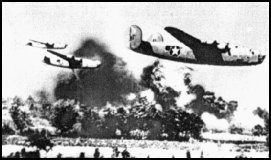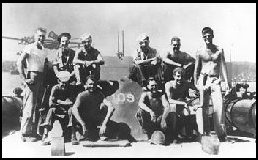 American B-24 Liberators making their bombing runs at Ploesti |
Project 60: A Day-by-Day Diary of WWII
Remembering the First Fight Against Fascism |
 Happier days for the crew of PT-109
Happier days for the crew of PT-109(JFK is standing on the right) |
 American B-24 Liberators making their bombing runs at Ploesti |
Project 60: A Day-by-Day Diary of WWII
Remembering the First Fight Against Fascism |
 Happier days for the crew of PT-109
Happier days for the crew of PT-109(JFK is standing on the right) |
In the early morning hours, a Japanese
task force consisting of the light cruiser Jintsu, and 9 destroyers made
another attempt to land reinforcements in the Solomons. An Allied naval group
under Admiral Ainsworth consisting of three light cruisers (Honolulu, HMNZS
Leander, and St. Louis) and 10 destroyers met off the coast of Kolombangara.
In the short battle, Leander was hit by a Japanese torpedo, severely
damaged and she withdrew. Nearly 3000 shells were fired at Jintsu, disabling her (the ship was later sunk by torpedoes). After reloading torpedoes, the
Japanese destroyers returned and managed to blow up an American destroyer and
severely damage the two remaining US cruisers. The Allied forces withdrew and
the Japanese landed 1200 troops on Vila Island. German offensive operations at Kursk
come to an end as one last attempt is made to break the Soviet lines on the
southern face of the bulge. It failed. Hitler suspended Operation 'Citadel'
and the vaunted Wehrmacht would never attempt a major strategic offensive on the
Russian front again. Meanwhile, the
Soviet offensive opposite Orel, north of Kursk continues to make good progress
against dogged German resistance. British forces continue to advance in
Sicily capturing Autusta and Raqusa. The "Herman Goring Division is beginning
to shift position to face the advancing British 51st Infantry
Division, 23rd Armored Brigade and Canadian 1st Infantry
Division (Harpoon Force) near Vizzini, while the British 8th Corps
opens attacks toward Catania and Lentini. The Japanese forces at Mubo, New
Guinea, are destroyed in heavy fighting. Senior Sergeant Mariy Sergeyevna
Borovichenko ended her military carrier as she had started it, facing
insurmountable odds in the face of the enemy. Her last act of heroism was to
place an anti-tank bomb on an enemy vehicle and rather than taking cover, used
her body to shield a wounded comrade. The detonation destroyed the German tank,
but shrapnel from the explosion killed her. She became a "Hero of the Soviet
Union, for her dedicated and selfless service to the Motherland", one of 92
women in the entire war to be so honored. The Soviet offensive on the Orel
salient expands as the Voronezh Front strikes back at
the German 4th Panzer and Army Detachment Kempf south of Kursk.
In other fighting on Sicily, American
forces secure the Biscari airfield and Niscemi while British forces capture
Vizzini. A major air battle is fought over
Rendova. American pilots clamed over forty Japanese planes at a cost of only 3
friendly craft. In Sicily, Patton's 7th
Army, relegated to a minor roll of protecting Montgomery's left flank. Stung
by the Alexander's decision to give Bradley's 2nd Corps front to
Montgomery, Patton decides to drive west to Polermo with half his army while 2nd
Corps is stuck advancing north through the trackless mountains. In a statement by Churchill and
Roosevelt to the people of Italy, the two leaders said, "The
sole hope for Italy's survival lies in honorable capitulation to the
overwhelming, power of the military forces of the United Nations. If you
continue to tolerate the Fascist regime, which serves the evil power of the
Nazis, you must suffer the consequences of your own choice . . . we are
determined to destroy the false leaders and their doctrines which have brought
Italy to her present position." Editor's
Note: To those who still feel Bush is the second coming of Churchill, compare
the statement above to "Smoke 'em out" and "Bring 'em on." Allied
forces continue to advance in Sicily. The US 3rd Infantry Division
engages in heavy fighting at Agrigento and Porto Empedocle. The British 50th
Infantry Division establishes a brigehead at the Primrose Bridge across the
Simeto River and the Canadian 1st Infantry Division captures
Caltagirone and moves on toward Piazza Armerina. Manstien's
defeated panzers begin to give ground on the southern edge of the Kursk bulge as
Soviet Voronezh Front
counter-attacks develop into general offensive. July 17, 1943 The Soviet Southwest Front (commanded
by General Malinovsky) joins the attacks hitting German positions around
Voroshilovgrad. To the north, Central Front's attacks toward Orel are
temporarily checked as German tanks counterattack the spearheads. South of Kursk,
the German remnants of the 4th Panzer Army continue their fighting
withdrawl. American air attacks on Bouganville hit
Japanese naval forces hard, sinking a destroyer. Patton's free-wheeling armored columns continue their romp over western Sicily capturing Caltanisetta and cutting the Palermo-Enna road. Canadian forces capture Valguarnera in the interior while on the east coast, British are stopped by stubborn resistance north of the Simeto River. July 19, 1943 Patton's armored columns continue to
drive north and west toward Palermo. Montgomery's forces are still unable to
move forward, and he shifts his spearheads inland aiming at Gerbini, Agira and
Leonforte. Canadian and American forces in Sicily
continue to advance capturing Enna and Menfi while the British continue to be
thwarted by heavy resistance. Italian forces begin to surrender en masse. The first "island hopping"
operation starts in the Pacific American forces land on Vella Lavella in an
attempt to bypass the Japanese stronhold at Kolombangara. The Allies continue to advance in
Sicily, capturing Gerbini, Leonforte, Corleone and Castelvetrano. Patton's 2nd Armored
Division drives into Palermo and completes the isolation of 45,000 Italian
troops in western Sicily. German mobile forces were able to avoid the advance
and withdraw in good order to the northeast. Patton's attack continues as his spearheads turn toward Messina along the northern coastal road. His forces reach Termini Imerese. Other 7th Army forces capture Trapani and Marsala. RAF Bomber Command continues its terror
bombing campaign against German cities, this night hitting Hamburg with 780
bombers carrying 2300 tons of bombs. The highlight of the evening raid was the
first use of "chafe", thin strips of metal foil dropped from planes to
confuse German radar. It worked remarkably well as only 12 planes were lost in
the raid The Italian Fascist Grand Council met
for the first time since December 1939. The topic of debate was the continued
leadership of Mussolini. In the end, the council voted 19-7 to remove el Duce
from command of all Italian forces. In Sicily, the drive of the 45th Infantry Division on the northern coast continues as Cefalu is captured. Further inland, American forces move toward Nicosia. Mussolini is arrested on orders of King
of Italy. Marshal Badoglio, a national war hero from the First World War, is
declared Prime Minister. His first acts are to declare martial law, outlaw the
Fascist Party, and incorporate the Fascist militias into the regular armed
forces thus removing Mussolini's muscle from the political equation. Hitler,
knowing this was in the works, ordered his pre-positioned forces into southern
Italy to disarm the renegade Italians and secure the situation for his ends. Hamburg continues to burn a day after
the RAF visited the city. Fires could be seen 200 miles away. The US Army Air
Force bombed the city during the day, creating even greater destruction, leaving
100,000 people homeless. Patton's headlong advance comes to a
screeching hault as the forces driving along the northern coast meet stiff
resistance. IN an attempt to break the deadlock on his front, Montgomery
launches a set piece attack by British and Canadian forces on Agira. With the collapse of the Kursk Offensive and the invasion of Sicily, Hitler orders the transfer of several units, including the 1st SS Panzer Division west. Heavy fighting is reported in Sicily as
attacks at Agira and Nicosia occur. The German theater commander, General
Kesselfing, orders preparations to begin for the evacuation of the island. RAF Bomber Command hits Hamburg again,
this time with 722 bombers. Nine square miles of the city are left burning. The Japanese evacuate the 6000-man
garrison off Kiska island in the Aleutians. The Americans are left completely in
the dark and continue with their plans to invade the island. In the Solomon Islands, American
attacks intensify as ground forces move toward "Horseshoe Hill". Air attacks
against Japanese naval forces at Rabaul result in the sinking of two Japanese
destroyers. After very heavy fighting American forces capture Nicosia while the Canadians take Agira. In an attempt to relieve the pressure
on German units between Kharkov and Orel, the Germans open an offensive by the 3rd
Panzer Corps (Army Group A) along the Mius River north of Taganrog. The attack
fails to make any impression on the Red Army forces in the area. Soviet forces launch limited
counter-attacks against the German positions along the Mius River, thus ending
the German attacks. US forces capture Santo Stefano while British and Canadian troops move toward Regalbuto and Centuripe on Sicily.
RAF Bomber Command continues to kick at
the carcass of Hamburg, launching yet another raid on the city. Horrible terrain and a reorganized and
energized enemy combine to bring the advance in Sicily to a halt. Heavy fighting
is reported around Troina, Regalbuto and Cenuripe. On the eastern front, Hitler permits the withdraw of forces in the Orel salient (which are already retreating on their own. Another Soviet female hero falls as Lt.
Lydia Vladimirovna Litvak was reported missing after attacking a group of German
bombers near Donetsk. In her carrier, she was credited with 12 kills, 4 assists
and 168 combat missions. Her combat carrier lasted less than a year and she was
wounded twice in that time. Her "Hero of the Soviet Union" medal was not
awarded until 1990. August 2, 1943 The Allies continue to desimate Hamburg
as the 9th raid in 8 days is launched against the pile of rubble
formerly known as a city. As of this day, more bombs have fallen on Hamburg than
were dropped on London during the entire blitz. 50,000 civilians were killed in
this city alone, more than all of the civilians lost in England during the
entire war so far. Heavy fighting continues in Sicily as
the Allies make limited progress. The Canadians capture Regalbuto while the
British take Centuripe. The Americans make progress in the
Solomon Islands as they reach Munda airfield. The Japanese begin to withdraw
some of their more exposed garrisons to Kolombangara where they intend to make
their last stand. The Soviet offensive continues as
Znamenskaya falls. 1941 Archive: 1942 Archive: 1943 Archive: Special Editions: Editor's Corner Archive: Hitler's Angle "The story of Prescott Bush and his association with the Nazis begins just before the end of World War I..." The Past Through Tomorrow "It is quite frightening to realize just how similar our nation's actions have been and appear to be heading when compared this way..." Afghanistan and Vietnam: When the "war against terrorism" began, many knowledgeable people warned that our operations in Afghanistan would turn into another Vietnam. Want to Win - Think Before You Lash Out - "If we are serious about taking the war to the enemy, it is time to look ..." The First Fight Against Fascism - We must remember the Spanish Civil War also. Arguing Victory - "... Each nation who fought against fascist tyranny in WWII brought with it part of whole needed to defeat that evil..." War, Glory, Honor and Remembrance - "War is a brutal and savage insult on human society..." The First
Casualty... in time of war, those in power are even more inclined to
hide the truth, since that truth is often manifest in the most gruesome and
terrible acts. Those wishing to contribute items. stories or comments should contact D.A. Friedrichs |